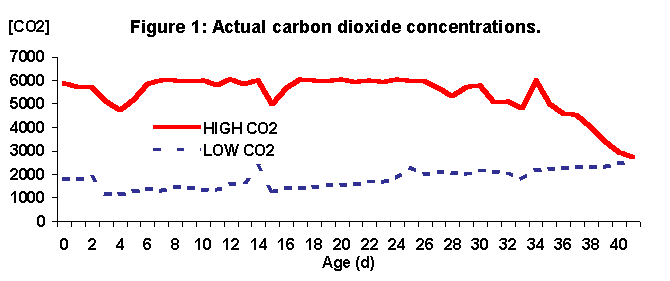| |
Problem
Air quality is often an issue in broiler production. Unfortunately, poor air qaulity can also lead to problems with ascites. Barns with poor air quality may have high levels of carbon monoxide (CO), carbon dioxide (CO2), ammonia (NH3), or dust. Bad air can reduce growth performance and increase the potential for respiratory disease. An experiment was performed to measure the effect of high levels of carbon dioxide on growth rates and if ascites-related mortality was increased.
Approach
Six hundred male broilers were housed in four pens (150 birds/pen) for 42 days. Two pens of the pens at a low CO2 concentration (600 ppm at day 0). The CO2 level was gradually increased to 2500 ppm at day 42. The other two pens were reared at a CO2 level of 6000 ppm from 0 to 35 days; from 35 to 42 days the CO2 level was decreased to 2500 ppm (Figure 1).
Carbon dioxide was produced both by the birds and by natural gas brooders in the pens. Carbon dioxide levels were controlled by increasing or decreasing ventilation rates.
At 42 days of age ascites scores were determined by examining the hearts from all 600 birds. Right ventricle area and right ventricle weight (two different methods of assessing ascites in broilers) were measured. Oxygen concentration was also measured on day 42.

Results and discussion
At 4 wk, the oxygen level was 20.8% in the LOW CO2 treatment (2300 ppm CO2). The HIGH CO2 treatment had 20.0% oxygen and 5800 ppm of CO2.
The difference in oxygen levels between the two treatments was 8000 ppm. The reduction in oxygen levels is twice as large as the increase in carbon dioxide levels (a difference of 3500 ppm CO2) between the two treatments.
Final body weight (growth rate), total feed consumption, and feed conversion efficiency were not significantly different between the two treatments. There were no differences in ascites score, right ventricle area, or right ventricle weight. Overall mortality was similar between treatments.
Previous studies have shown that when environmental oxygen is reduced the lungs cannot supply as much oxygen to the bird; reduced oxygen should increase the incidence of ascites. For example, oxygen levels of 20.6% can impact the incidence of ascites when birds are housed at 26.7°C. This suggests that oxygen availability, temperature, and growth rate all play a role in the onset of ascites.
The reduction in oxygen levels corresponding to a 3500 ppm difference in CO2 did not increase in the incidence of ascites in this flock.
R. H. McGovern, J. J. R. Feddes, M. J. Zuidhof, J. A. Hanson, F. E. Robinson, and I. Edeogu
University of Alberta
Source: Poultry Research Centre News - Vol. 7 No. 1, May 1998 |
|